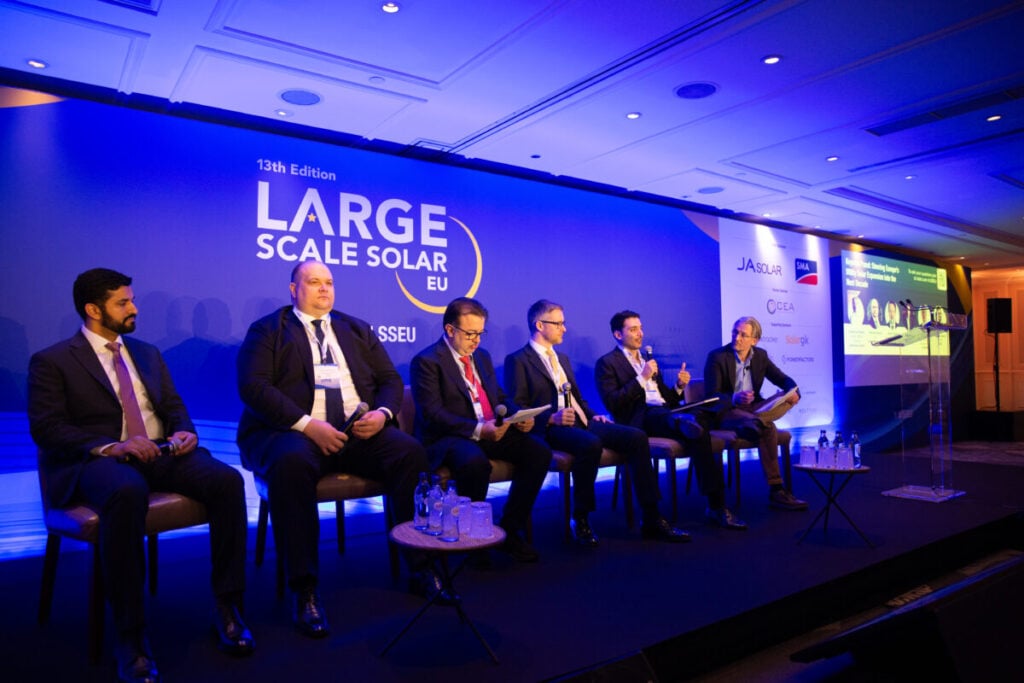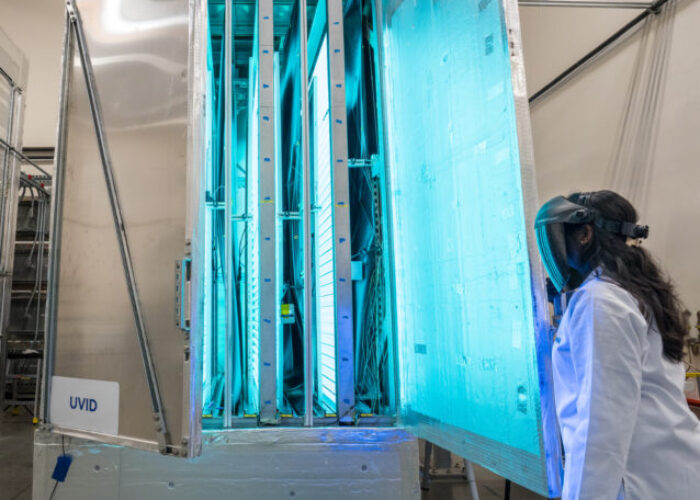
Financial uncertainty and imminent market consolidation will define the next decade of Europe’s utility-scale solar market, according to speakers at the Large Scale Solar Europe conference.
Speaking in Lisbon this morning, keynote panel moderator Lennart van Walsum, director, EMEIA and Americas at the Global Solar Council, said the PV industry “is growing up” as it moves away from the government-backed schemes of ten years ago to “market solutions” and significant corporate power purchase agreements (PPAs). Van Walsum said this is making solar PV “attractive to a wider range of investors”.
Try Premium for just $1
- Full premium access for the first month at only $1
- Converts to an annual rate after 30 days unless cancelled
- Cancel anytime during the trial period
Premium Benefits
- Expert industry analysis and interviews
- Digital access to PV Tech Power journal
- Exclusive event discounts
Or get the full Premium subscription right away
Or continue reading this article for free
Market competition and consolidation
Alberto Paturzo, partner, southern Europe at renewable energy firm Bluefield, described a move from “Renewables 1.0” 15 years ago, where renewables were “at the fringes” of the energy sector, and the “only driver was to promote decarbonisation”, to “Renewables 2.0”.
He said that in the coming ten years, the shift towards market dynamics and competitive revenues would continue to gather pace, including “integration with batteries and colocation; to a sector focused on the market where [government schemes] are just a part of the game, not the whole thing”.
Long-term corporate PPAs will become an increasingly important part of Europe’s renewable energy market, panelists said. Indeed, reports published earlier this year by LevelTen Energy and PexaPark both show growing corporate demand for long-term PPAs across the continent, partly due to uncertainty around the future of government subsidies and contracts for difference (CfD) schemes.
Patrizio Donati, co-founder & director at renewables developer Terrawatt, said that financiers for solar projects “remain unhappy to take on merchant risk [for PV projects], so these long-term PPAs – and the few CfDs that are still available – are going to be important drivers that help the market grow over the next few years. Or at least to get these megawatts on the ground.”
Despite this shift, money is still flowing into the sector. Bart White, head of energy EMEA, structured finance at Santander, said that the global industry saw “around US$120 billion” of investment into solar, “around half of that was in Europe. That is an increase from just over US$90 billion in 2023.”
The upshot of this increased maturity and market competition will be a consolidation towards bigger players, according to Aldevinas Burokas, CEO, GoldenPeaks Capital Trading.
“I believe the market is entering a consolidation phase,” Burokas said. In the past, “even small market participants were able to develop a project, participate in a state-organised auction etc.”
However, the removal of state support has meant “these players don’t have a lot of options available to them. One [option] is to approach utilities and selling their production at 30-40% discount.”
As this type of competition is increasing, Burokas said that increased project and investment costs mean that this is no longer a viable business model.
Developers increasingly need the knowledge and ability to be “more efficient” in constructing and marketing their production with corporate buyers and agreeing balanced and long-term PPAs.
“To do that, you need fairly big trading and sales capabilities. That’s expensive,” he said. Developers will need active project pipelines and “big portfolios”, he continued.
“That’s not possible if you’re developing 50-100MW a year.”
The future is “consolidated, larger companies” across the solar PV sector that are more able to negotiate and sustain long-term corporate PPAs in a competitive environment.
Over the next five years, Europe will see “Less and less independent, small developers. They will be forced to be acquired by larger market participants. At the end of the day, you have to have a certain negotiating power…to balance out the relationships [between developer and offtaker],” Burokas said.
However, while larger players have advantages, “large institutional players tend to not be able to reach certain parts of the market, particularly when it comes to finding the right piece of land and getting those permits at a local level,” Donati said. “A lot of times we need to be very deeply embedded within local ecosystems and infrastructures in order to get to the right result.”
He said that as larger players are investing in larger utility-scale solar PV projects, smaller companies – like Terrawatt – can “come in and snap up those 5MW, 10MW, 15MW-sized plants.”
Economic uncertainty
Panellists also discussed the challenges facing the sector around geopolitical and macroeconomic change and uncertainty.
In 2025 and 2026, “it’s inevitable that the macroeconomic is going through a period of change,” Bart White said. “We have some volatility in interest rates [and] inflation; some uncertainty around growth expectation which flows into central bank uncertainty in terms of interest rates.
“We clearly have the advent of tariffs, and the world is going to need to find a new equilibrium in terms of global trade and supply chain.”
However, White said this uncertainty gives “sophisticated” solar developers “a lot of opportunity.”
“This market is all about winners,” he said. “It’s about the people who can join the dots and do trades. If you’re going to be brave, if you’re going to be forward-thinking, if you’re going to be able to model out different scenarios and actually transact, then you’ll be able to get fantastic projects done. Ultimately, none of us make any money from projects that don’t get built.”
A self-confessed “optimist”, White’s assessment isn’t unanimous across the industry. Norwegian consultancy DNV identified political and economic challenges which have had “worldwide ripple effects” and threaten to “slow the transition” to renewable energy globally.
DNV’s report said that, while the “boom” in solar and energy storage deployments has ushered in the replacement of fossil fuel capacity with renewables in real terms, the shifting global political agenda and its attendant uncertainty threatens to distract political will and funding from the energy transition.






